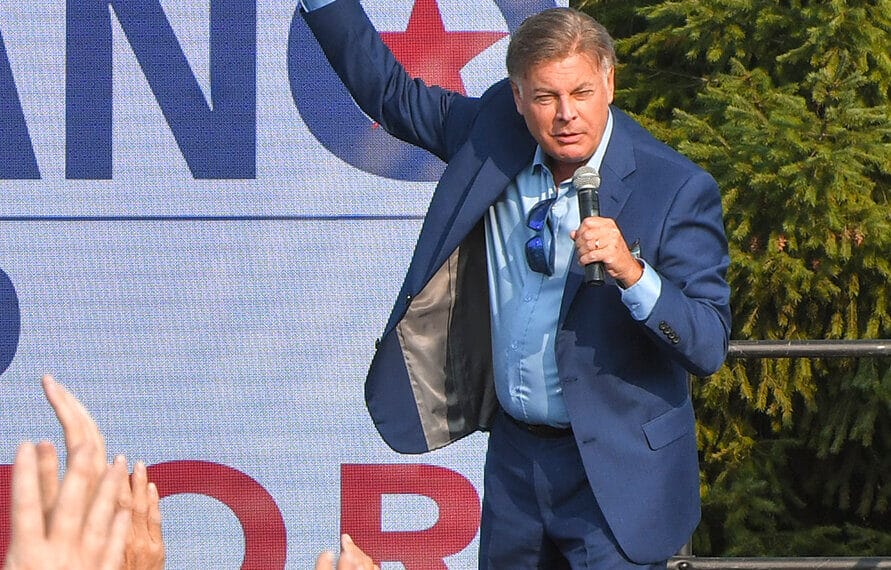The Gist:
Senator JD Vance from Ohio is set to campaign in Pennsylvania alongside Lance Wallnau. This comes in the wake of Wallnau’s controversial comments regarding Vice President Kamala Harris’s debate performance, which he labelled as “witchcraft.” This statement has sparked conversations around the political discourse and the rhetoric used during campaigns.
The collaboration between Vance and Wallnau raises eyebrows, especially with the current political climate where expressions can provoke strong reactions. Vance’s choice to align with Wallnau, known for his polarising views, suggests a strategic move to energise their support base. This situation underlines the importance of understanding how language and imagery in politics can influence public perception and voter sentiment.
The Good:
- Engagement Opportunities: Campaigns involving different figures can attract diverse audiences, enhancing civic engagement and participation in the electoral process.
- Awareness of Issues: Such appearances can highlight key issues or concerns that resonate with the public, prompting important discussions on political matters.
- Electoral Strategy: Innovative campaigning techniques can create strategic advantages for candidates, energising their supporters and improving voter turnout.
- Dialogue on Public Figures: The attention drawn from controversial statements can stimulate discussions about the performance and actions of public officials, encouraging accountability.
- Strengthening Political Bonds: Collaborations can help solidify ties between politicians and influential figures, creating a united front to advocate for shared goals.
The Bad:
- Polarisation: Campaigns like this might deepen existing divides, creating more hostility between different political factions.
- Controversial Rhetoric: Using charged language, such as Wallnau’s comment, can overshadow more substantive discussions and lead to misunderstanding or backlash.
- Potential Misinformation: Such commentary may be taken out of context or misconstrued, leading to misinformation among voters about the candidates and their positions.
- Negative Public Perception: Aligning with controversial figures can risk damaging a candidate’s public image, making them appear out of touch or extreme.
- Distraction from Issues: The focus on sensational comments may divert attention away from genuine policy discussions that are crucial for the electorate.
The Take:
Senator JD Vance, a Republican from Ohio, is preparing for a campaign swing in Pennsylvania, where he will join forces with Lance Wallnau. Lance Wallnau is known for his outspoken views and has recently sparked controversy by describing Vice President Kamala Harris’s debate performance as “witchcraft.” This remark has made headlines and highlights the contentious nature of political discussions in today’s climate.
The pairing of Vance with Wallnau denotes a strategy aimed at galvanising support, especially among conservative voters. The duo’s appearance is expected to draw significant attention, not only for their political messages but also due to the polarising commentary made by Wallnau. His use of metaphorical language associated with witchcraft raises questions around the appropriateness and implications of such expressions in politics. It reflects a trend where political rhetoric has become increasingly colourful, often straying far from substantive discussions on policies and governance.
Vance, who has been vocal about his political beliefs and values, seems to be banking on the appeal of Wallnau’s rhetoric to ignite passion among potential voters. However, coupling with someone who uses contentious language could alienate moderate voters who might find such comparisons distasteful or offensive. The political landscape is sensitive, and the risk of alienating significant portions of the electorate is ever-present.
Certainly, there are positives in this collaboration. It brings engagement opportunities, encouraging people to participate in the electoral process. Campaign events accessible to various communities may indeed raise awareness about pressing issues. This type of engagement is vital in democracies where every voice matters. However, observationally, the downside holds substantial weight. The potential for increased polarisation is high, as those who disagree with Wallnau’s rhetoric may feel even more disenfranchised from the political discourse, making constructive dialogue more difficult.
As the campaign progresses, it will be pertinent to monitor how Vance and Wallnau’s partnerships evolve and what specific messages they choose to highlight during their appearances. An important aspect to consider is the degree to which they can navigate the fine line between energising their base and attracting moderate support. Vance’s strategy may hinge on his ability to harness Wallnau’s controversial popularity while ensuring that it doesn’t detract from his overall message or image.
In conclusion, while the collaboration may open doors for galvanizing support and raising awareness, it risks exacerbating divisions within the electorate. The ramifications of rhetoric used in political campaigns echo far beyond the immediate context—they shape public perception and can define the political narrative leading into future elections. Thus, it will be intriguing to see if Vance can effectively reconcile his campaigning strategy with the polarising implications of Wallnau’s statements as they work to secure votes in Pennsylvania.




